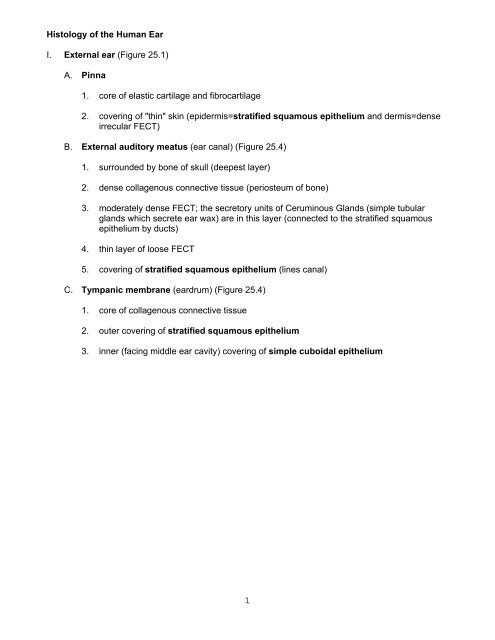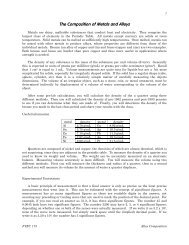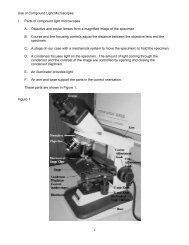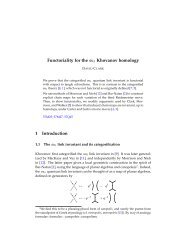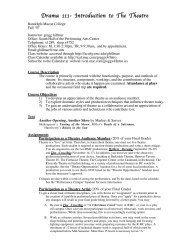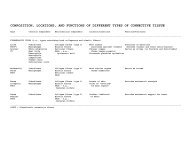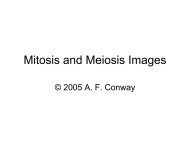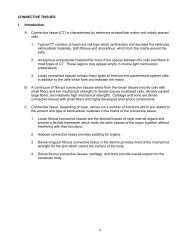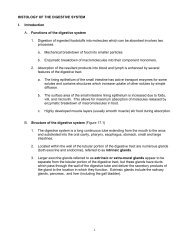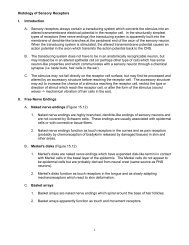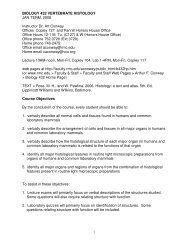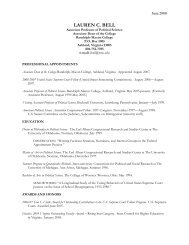Histology of the Human Ear I. External ear (Figure ... - Faculty.rmc.edu
Histology of the Human Ear I. External ear (Figure ... - Faculty.rmc.edu
Histology of the Human Ear I. External ear (Figure ... - Faculty.rmc.edu
Create successful ePaper yourself
Turn your PDF publications into a flip-book with our unique Google optimized e-Paper software.
<strong>Histology</strong> <strong>of</strong> <strong>the</strong> <strong>Human</strong> <strong>Ear</strong><br />
I. <strong>External</strong> <strong>ear</strong> (<strong>Figure</strong> 25.1)<br />
A. Pinna<br />
1. core <strong>of</strong> elastic cartilage and fibrocartilage<br />
2. covering <strong>of</strong> "thin" skin (epidermis=stratified squamous epi<strong>the</strong>lium and dermis=dense<br />
irrecular FECT)<br />
B. <strong>External</strong> auditory meatus (<strong>ear</strong> canal) (<strong>Figure</strong> 25.4)<br />
1. surrounded by bone <strong>of</strong> skull (deepest layer)<br />
2. dense collagenous connective tissue (periosteum <strong>of</strong> bone)<br />
3. moderately dense FECT; <strong>the</strong> secretory units <strong>of</strong> Ceruminous Glands (simple tubular<br />
glands which secrete <strong>ear</strong> wax) are in this layer (connected to <strong>the</strong> stratified squamous<br />
epi<strong>the</strong>lium by ducts)<br />
4. thin layer <strong>of</strong> loose FECT<br />
5. covering <strong>of</strong> stratified squamous epi<strong>the</strong>lium (lines canal)<br />
C. Tympanic membrane (<strong>ear</strong>drum) (<strong>Figure</strong> 25.4)<br />
1. core <strong>of</strong> collagenous connective tissue<br />
2. outer covering <strong>of</strong> stratified squamous epi<strong>the</strong>lium<br />
3. inner (facing middle <strong>ear</strong> cavity) covering <strong>of</strong> simple cuboidal epi<strong>the</strong>lium<br />
1
II. Middle <strong>Ear</strong> (<strong>Figure</strong> 25.1, 25.3, 25.4, 25.5)<br />
A. Cavity<br />
1. surrounded by bone <strong>of</strong> skull<br />
2. dense collagenous connective tissue <strong>of</strong> skull periosteum<br />
3. thin layer <strong>of</strong> loose FECT<br />
4. covering <strong>of</strong> simple cuboidal epi<strong>the</strong>lium<br />
B. Ossicles<br />
1. core <strong>of</strong> bone<br />
2. same wall composition as cavity<br />
C. Eustacean tube<br />
1. same wall structure as cavity<br />
2. covering converts to pseudostratified columnar epi<strong>the</strong>lium with goblet cells as <strong>the</strong><br />
tube approaches <strong>the</strong> pharynx<br />
2
III. Inner <strong>Ear</strong> (<strong>Figure</strong> 25.1, 25.3, 25.7)<br />
A. Osseus Labyrinth<br />
1. cavity in temporal bone<br />
2. contains membranous labyrinth<br />
3. also contains perilymphatic fluid space between bone and membranous labyrinth which<br />
forms <strong>the</strong> vestibule and <strong>the</strong> outer channels <strong>of</strong> <strong>the</strong> cochlea (vestibular duct and tympanic<br />
duct)<br />
4. areas between bone and fluid spaces filled with loose FECT<br />
5. fluid spaces are lined with simple squamous epi<strong>the</strong>lium<br />
B. Membranous Labyrinth<br />
1. lined with simple squamous epi<strong>the</strong>lium in most areas<br />
2. lined with simple columnar epi<strong>the</strong>lium with "hair" cells in sensory areas<br />
3. lined with simple cuboidal or columnar epi<strong>the</strong>lium in fluid production/resorption areas<br />
4. epi<strong>the</strong>lium underlain by loose FECT in most areas<br />
C. Sensory Receptor Structures in <strong>the</strong> Inner <strong>Ear</strong> (<strong>Figure</strong> 25.8, 25.9)<br />
1. Common features <strong>of</strong> receptors<br />
a. Sensory receptors in all cases are "hair" cells.<br />
(1) "Hair" cells are columnar epi<strong>the</strong>lial cells in <strong>the</strong> wall <strong>of</strong> <strong>the</strong> membranous<br />
labyrinth.<br />
(2) "Hair" cells have an apical V-shaped array (viewed from <strong>the</strong> surface) <strong>of</strong><br />
microvilli.<br />
(3) "Hair" cells have ei<strong>the</strong>r a kinocilium (sensory cilium, found in hair cells in <strong>the</strong><br />
maculae and <strong>the</strong> ampullae) or <strong>the</strong> basal body <strong>of</strong> a kinocilium (in <strong>the</strong> hair cells <strong>of</strong><br />
<strong>the</strong> Organ <strong>of</strong> Corti in <strong>the</strong> cochlea) is located at <strong>the</strong> apex <strong>of</strong> <strong>the</strong> "V" shaped array<br />
<strong>of</strong> microvilli.<br />
b. The processes (microvillae) <strong>of</strong> <strong>the</strong> hair cells are embedded in gelatinous accessory<br />
structures which modify <strong>the</strong> stimuli (gravity, movement, sound) into mechanical<br />
motion <strong>of</strong> <strong>the</strong> hair cell processes.<br />
3
2. Receptor structures in <strong>the</strong> inner <strong>ear</strong><br />
a. Maculae (<strong>Figure</strong> 25.1, 25.4, 25.11)<br />
(1) Structure<br />
(a) Two maculae (oriented at right angles to each o<strong>the</strong>r) occur in each <strong>ear</strong>.<br />
- maculus utriculus in <strong>the</strong> utricular chamber<br />
- maculus sacculus in <strong>the</strong> saccular chamber<br />
(b) "Hair" cells <strong>of</strong> <strong>the</strong> maculae are embedded in gelatinous material containing<br />
otoliths.<br />
(2) Function<br />
- otoliths are crystals <strong>of</strong> calcium carbonate and protein<br />
- otoliths make <strong>the</strong> gelatinous material more dense than <strong>the</strong> fluid around it<br />
(a) The dense otoliths cause <strong>the</strong> <strong>the</strong> gelatinous material to be pulled down by<br />
gravity.<br />
(b) The movement <strong>of</strong> <strong>the</strong> gelatinous material bends <strong>the</strong> hair cell processes.<br />
(c) Bending <strong>of</strong> <strong>the</strong> hair cell processes increases or decreases <strong>the</strong> rate <strong>of</strong> nerve<br />
impulses going to <strong>the</strong> CNS.<br />
(d) The receptors are actually sensing gravity, but <strong>the</strong> organism's CNS<br />
interprets <strong>the</strong> signals as body orientation (relative to gravity).<br />
b. Ampullae (and semicircular canals) (<strong>Figure</strong> 25.1, 25.4, 25.10, Plate 104)<br />
(1) Structure<br />
(a) One ampulla is located in <strong>the</strong> enlarged chamber n<strong>ear</strong> one end <strong>of</strong> each <strong>of</strong><br />
<strong>the</strong> semicircular canals <strong>of</strong> <strong>the</strong> inner <strong>ear</strong>.<br />
(b) The 3 semicircular canals in each <strong>ear</strong> are oriented at right angles to each<br />
o<strong>the</strong>r.<br />
(c) The processes <strong>of</strong> <strong>the</strong> hair cells <strong>of</strong> each ampulla are embedded in<br />
gelatinous material which forms a dam-like structure (<strong>the</strong> cupula) across<br />
<strong>the</strong> semicircular canal.<br />
(d) Each semicircular canal is filled with endolymphatic fluid.<br />
4
(2) Function<br />
(a) When <strong>the</strong> organism's head moves, <strong>the</strong> fluid in <strong>the</strong> semicircular canal tends<br />
to stay in place due to inertia.<br />
(b) The head movement <strong>the</strong>refore results in <strong>the</strong> wall <strong>of</strong> <strong>the</strong> canal moving past<br />
<strong>the</strong> fluid.<br />
(c) Movement <strong>of</strong> <strong>the</strong> wall relative to <strong>the</strong> fluid causes <strong>the</strong> fluid to press on <strong>the</strong><br />
"dam" in <strong>the</strong> ampulla (<strong>the</strong> cupula) formed by <strong>the</strong> gelatinous mass attached<br />
to <strong>the</strong> hair cells.<br />
(d) Bending <strong>of</strong> <strong>the</strong> cupula in turn moves <strong>the</strong> processes <strong>of</strong> <strong>the</strong> hair cells.<br />
(e) Movement <strong>of</strong> <strong>the</strong> processes on <strong>the</strong> hair cells changes <strong>the</strong> frequency <strong>of</strong><br />
impulses in <strong>the</strong> sensory neurons which receive inputs from <strong>the</strong> hair cells.<br />
(f) The organism experiences stimulation <strong>of</strong> <strong>the</strong> ampullae as motion, but <strong>the</strong><br />
stimulus is actually acceleration (a change in <strong>the</strong> rate <strong>of</strong> motion).<br />
c. Cochlea (<strong>Figure</strong> 25.1, 25.4, 25.13, 25.14, 25.17, 25.21, Plate 104, Plate 105)<br />
(1) Structure<br />
(a) The cochlea is a tubular structure which is coiled into a snail shell-like<br />
spiral.<br />
(b) Two outer canals run <strong>the</strong> full length <strong>of</strong> <strong>the</strong> cochlea.<br />
- <strong>the</strong> vestibular canal (scala vestibuli)<br />
- <strong>the</strong> tympanic canal (scala tympani)<br />
(c) The outer canals are continuous at <strong>the</strong> tip <strong>of</strong> <strong>the</strong> cochlea.<br />
(d) A central canal (<strong>the</strong> cochl<strong>ear</strong> duct) is located between <strong>the</strong> two outer<br />
canals and does not connect directly to <strong>the</strong> two outer canals.<br />
(e) The sensory cells (hair cells) are embedded in <strong>the</strong> columnar epi<strong>the</strong>lium that<br />
forms <strong>the</strong> "floor" <strong>of</strong> <strong>the</strong> cochl<strong>ear</strong> duct. The complex <strong>of</strong> hair cells and<br />
supporting cells is called <strong>the</strong> Organ <strong>of</strong> Corti.<br />
(f) Two arrays <strong>of</strong> hair cells (inner and outer) run longitudinally within <strong>the</strong> organ<br />
<strong>of</strong> Corti.<br />
(g) The microvilli <strong>of</strong> <strong>the</strong> hair cells are embedded in a gelatinous structure (<strong>the</strong><br />
tectorial membrane) which runs longitudinally in <strong>the</strong> organ <strong>of</strong> Corti.<br />
(h) One edge <strong>of</strong> <strong>the</strong> organ <strong>of</strong> Corti (both tectorial membrane and sensory<br />
epi<strong>the</strong>lium) is anchored to bone (<strong>the</strong> osseus spiral lamina). The o<strong>the</strong>r edge<br />
is much more flexible.<br />
5
(2) Function<br />
(a) Sound waves in <strong>the</strong> air enter <strong>the</strong> outer <strong>ear</strong> and cause vibrations <strong>of</strong> <strong>the</strong><br />
tympanic membrane (<strong>ear</strong>drum).<br />
(b) Vibration <strong>of</strong> <strong>the</strong> tympanic membrane causes vibrations <strong>of</strong> <strong>the</strong> middle <strong>ear</strong><br />
ossicles.<br />
(c) Vibration <strong>of</strong> <strong>the</strong> stapes causes vibration <strong>of</strong> <strong>the</strong> oval window in <strong>the</strong> surface <strong>of</strong><br />
<strong>the</strong> vestibular canal at <strong>the</strong> base <strong>of</strong> <strong>the</strong> cochlea.<br />
(d) Vibration <strong>of</strong> <strong>the</strong> oval window causes vibration (pressure waves) in <strong>the</strong> fluid<br />
<strong>of</strong> <strong>the</strong> vestibular canal and (through its communication with <strong>the</strong> tympanic<br />
canal at <strong>the</strong> apex <strong>of</strong> <strong>the</strong> cochlea) <strong>the</strong> tympanic canal.<br />
(e) Where <strong>the</strong> pressure waves in <strong>the</strong> outer canals (vestibular and tympanic)<br />
are out <strong>of</strong> phase, <strong>the</strong>y result in vertical vibration <strong>of</strong> <strong>the</strong> organ <strong>of</strong> Corti.<br />
(f) Vertical movement <strong>of</strong> <strong>the</strong> organ <strong>of</strong> Corti causes <strong>the</strong> tectorial membrane to<br />
move laterally on <strong>the</strong> surface <strong>of</strong> <strong>the</strong> hair cells. The conversion <strong>of</strong> vertical<br />
movement into lateral movement is due to <strong>the</strong> lack <strong>of</strong> movement <strong>of</strong> <strong>the</strong><br />
attachment <strong>of</strong> <strong>the</strong> tectorial membrane and <strong>the</strong> sensory epi<strong>the</strong>lium with <strong>the</strong><br />
osseus spiral lamina.<br />
(g) This system converts both frequency (determines <strong>the</strong> location along <strong>the</strong><br />
organ <strong>of</strong> Corti at which maximum vibration occurs) and intensity<br />
(determines <strong>the</strong> extent <strong>of</strong> <strong>the</strong> vibrating area) <strong>of</strong> sound into mechanical<br />
movement <strong>of</strong> hair cell processes. Fur<strong>the</strong>r processing <strong>of</strong> <strong>the</strong> signal in <strong>the</strong><br />
spiral ganglion and in <strong>the</strong> auditory centers in <strong>the</strong> brain app<strong>ear</strong> necessary to<br />
produce <strong>the</strong> ability to discriminate among sounds that is demonstrated by<br />
musicians.<br />
6


